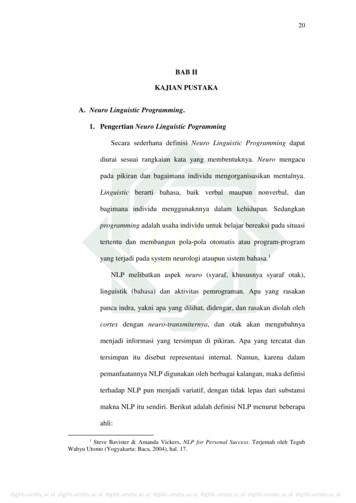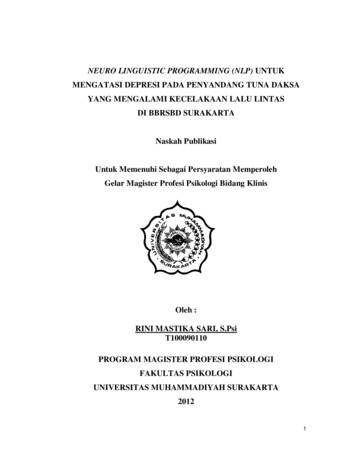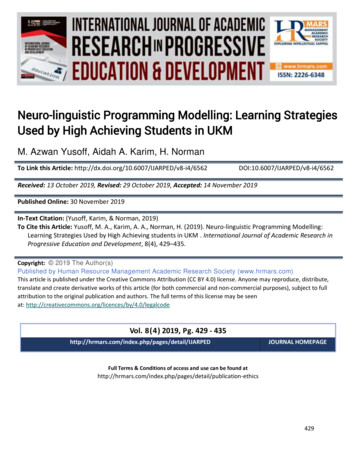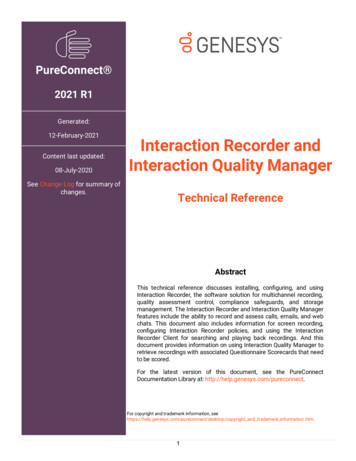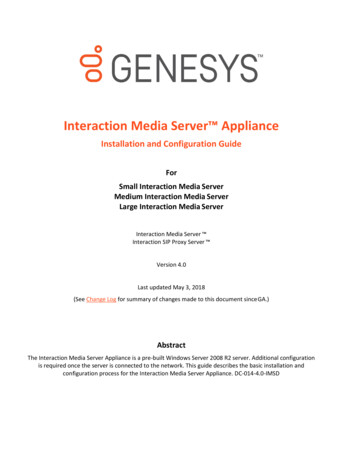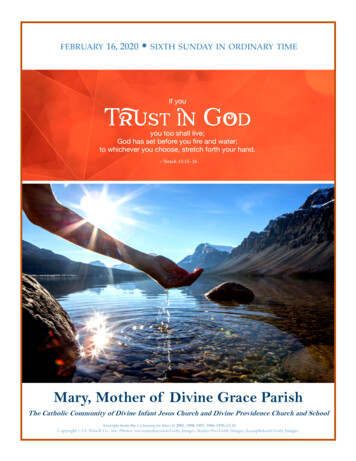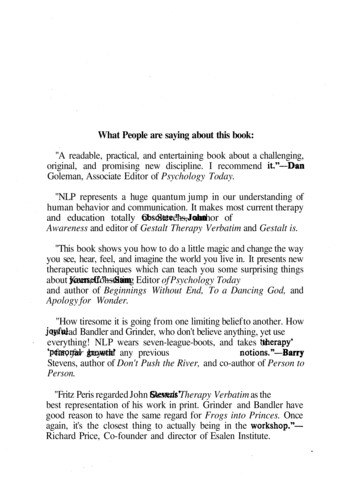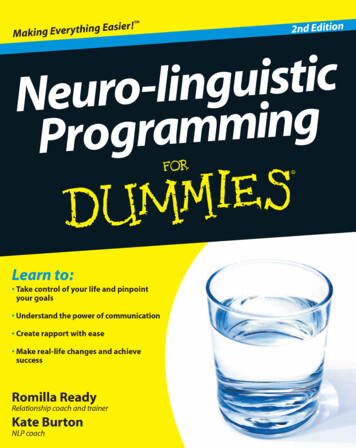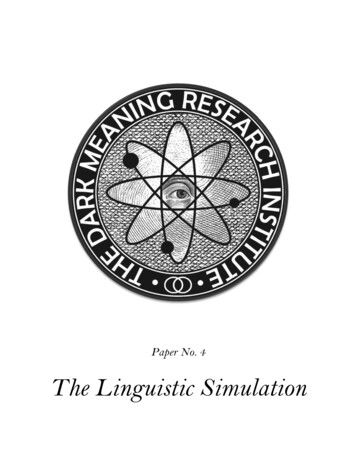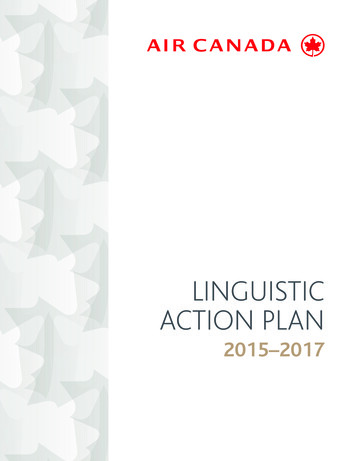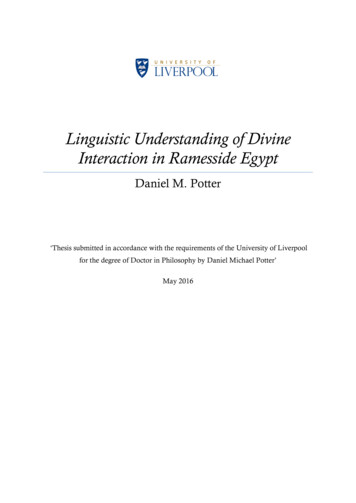
Transcription
Linguistic Understanding of DivineInteraction in Ramesside EgyptDaniel M. Potter‘Thesis submitted in accordance with the requirements of the University of Liverpoolfor the degree of Doctor in Philosophy by Daniel Michael Potter’May 2016
iAbstractLinguistic Understanding of Divine Interaction in Ramesside EgyptDaniel M. PotterThis thesis sets out to examine a number of linguistic topoi from Ramesside Egypt whichare utilised to express an understanding of divine interaction with humanity. In order toassess each of these topoi, the methodologies and axioms of the fields of Pragmatics andCognitive linguistics are employed. Previously, theoretical insights from both of thesefields have not been applied fully to Egyptian texts of a religious nature. Through the indepth examination of these topoi, this thesis aims to foster a greater comprehension of theways in which individuals during this period understood divine interaction and how thisunderstanding was figured in rhetorical devices. The selected corpus dates from theAmarna period to the start of the Third Intermediate pefriod and includes royal and privatemonuments, as well as hieratic material. The inclusion of examples from a variety oflanguage registers and genres allows for a wider assessment of each theme.The introduction presents the dataset and discusses the individual sources. This sectionalso presents the theoretical backgrounds of Pragmatics and Cognitive Linguistics, as wellas discussing potential cross-cultural variances.Chapter 1 deals with the topoi of the “hand” and the “arm(s)” of the divine. The phrase“the hand of god” is highly familiar to western thought, and this chapter assesses the useof Drt “hand” and a(wy) “arm(s)” in relation to the divine. Though both lexemes have beenregularly translated as “hand”, in reality both lexemes function as separate idioms,appearing in separate contexts concurrently within a number of sources. Drt “hand”represents a close and palpable interaction with human characters whereas a(wy) “arm(s)”is used to describe the control of more distant, abstract concepts. As both lexemes arefrequently utilised a part of compound prepositions, the issue of grammaticalization is alsoaddressed, and to what extent they are semantically meaningful within such constructions.Chapter 2 assesses the use of the verbs “come” and “go” in relation to divine motion. Asdeictic verbs of motion, which encode egocentric information, they may only beunderstood in terms of the speaker and their worldview, and the application of such verbsillustrates how the divine are perceived within their movement. When a positiveinteraction is iterated, the verb “come” is utilised in order to place focus upon theindividual as GOAL (deictic centre) of the movement. Within the gathered corpus, thedivine do not “go”. Instead, when expressing negative interaction “come” is negated orthe divine movement is described as rotational (i.e. “turning” as opposed to a movementfrom/towards the individual). Each interaction is described in the same manner as humaninteractions and is highly attentional. A number of instances also show elements ofpresupposition of divine interaction when requested.Chapter 3 examines instances in which individuals describe “finding” or having “found”the divine. From analysis of the participant roles within the utterances as well as acontextual analysis, it is clear that the divine are viewed as real world, interactivecharacters. In all the instances examined gm(i) is used to express perceptual discovery.Each of the studies shows a linguistic understanding of a highly interactive divine. Eachexpression is couched in the same rhetoric as human interactions and is highly rooted inthe perception of the individual speaker/writer/composer.
iiAcknowledgementsThough it is often stated in relation to large pieces of written work, I am certain that Icould not and would not have completed this thesis without the support and guidance ofa great number of people.My first thanks must go out to Dr Roland Enmarch. His tireless work throughout myresearch is truly invaluable to me. He has always been a pleasure to work with and I amperennially grateful for his shrewd ability for discerning what I really mean when I ambeing vague. I am also greatly thankful for all the encouragement and input provided byProf. Mark Collier throughout my studies, from my UG interview to the present day.For a lot of the time within my study I also worked in a number of Museums. Myexperiences in the Worlds Museum Liverpool and the Garstang Museum have beenthoroughly enjoyable. It really does help when you get to work with great people.Throughout my studies I have also been lucky to have some fantastic colleagues. I haveshared my office, my time and my distractions with all of them. Special mention must goto Jan Haywood for many afternoons discussing anything under the sun, Anne Landborgfor being a great teaching companion, Allison Williams for sharing the PhD experiencewith me whilst also persistently correcting my French (I promise I will get better) andGuen Taeitti for teaching me “useful” Greek. Thank you to each and every one of you. Iam also fortunate to have a close group of friends who have endeavoured to keep megrounded; reminding me that if they can finish a PhD then so can I, so thanks to Jay, Ez,Nick and Adam.My most heartfelt thanks go to my family. When I have been away for too long or havebeen distracted, they have always been there for me at any and every time. To my Mumand Dad who always told me that I could do anything I put my mind to, and to Kim whoreminded me that a quotable knowledge of Disney films is just as useful as Egyptiangrammar.Finally, I dedicate this thesis to my Grandma.Liverpool, May 2016
iiiTable of ContentsAbstract . iAcknowledgements . iiAbbreviations . viiiIntroduction: Translating Religious Expression . 11.1 The Expression of Divine Interaction . 11.2 Dataset . 61.3 Using Cognitive Linguistics and Pragmatics to Understand the World . 111.3.1 Pragmatics and Implicature . 121.3.2 Cognitive Linguistics . 161.3.3 Cross-cultural variances . 191.4 Catalogue of Sources . 211.5 Outline of Methodology . 60Chapter 1: The Hand and Arm(s) of the Divine . 621.0 Introduction . 621.1 The Concept of the “Hand of god” . 621.2 Varied lexemes and translation . 651.3 Previous Research . 672.0 The Corpus . 682.0.1 Grammaticalization. 682.0.2 Corpus and Methodology . 812.1 Hieratic Sources . 822.1.1 EPISTOLARY . 82Example 1: P.Geneva D 192 (LRL 17) . 82Example 2: P.Geneva D 407 (LRL 8) . 82Example 3: P. BM EA 10417 (LRL 14) . 84Example 4: P. BM EA 10419 . 84Example 5: P.Leiden I 369 (LRL 1). 85Example 6: P. BM EA 75025 (Bankes ‘C’) - Palimpsest . 852.1.2 LITERARY . 96Example 7: O. Glasgow D. 1925.69 (O. Colin Campbell 4) . 96Example 8: O. UC 39614 (O.Petrie 11) The Prohibitions . 98
ivExample 9: P.Sallier IV verso (P.BM EA 10184) From a Letter Praising Thoth, written toa young Scribe . 100Example 10: P.Anastasi V (P. BM EA 10244) Prayer to Thoth for skill in writing (9,210,2) . 102Example 11: P.Anastasi II (P. BM E 10243) Fragments of text on the Verso . 103Example 12: The Tale of the Doomed Prince . 104Example 13: The Teaching of Amenemope . 1052.1.3 HYMNIC TRADITION . 116Example 14: P. Leiden I 350 recto . 1162.2 Private Monuments . 1182.2.1 PENITENTIAL STELAE . 118Example 15: Turin N 50046 . 118Example 16: BM EA 589 . 119Example 17: Turin N 50058 . 1202.2.2 TOMB INSCRIPTIONS . 123Example 18: The Great Hymn to the Aten in the Tomb of Ay . 123Example 19: TT 194- Djehutiemhab . 124Example 20: TT 409 - Samut called Kyky . 1252.2.3 STATUARY AND STELAE . 127Example 21: Berlin 6910- The Double Statue of Amenemope and his Wife. . 127Example 22: Musée Guimet C 21- Stela of Baki . 130Example 23: Berlin 2081 - Stela of the Scribe of the King, Hor. 131Example 24: Cairo CG 42185- Limestone Block statue of Roma-Roy . 1322.2.4 MISCELLANEOUS . 133Example 25: Inscribed Seats from Deir el-Medina (Turin N.50253, N.50258 andN.50259) . 1332.3Royal Monuments . 135Example 26: The Qadesh Poem of Ramesses II . 135Example 27: The Israel Stela of Merenptah (CG 34025/JE 31408) . 139Example 28: Ramesses III Prayer to Amun-Re (“Tablet of Gold”) . 141Example 29: Ramesses III Inscriptions at Medinet Habu . 1433.0 Results: Hand(s) and Arm(s) . 1553.1 Division of Drt and a(wy) . 1553.2 Hr-a(wy) and time . 160
v3.3 Creation of Idiom and Change over Time . 1613.4 Post-Ramesside Instances . 165Chapter 2: The Divine and the Deictic . 1671.0Introduction . 1671.1 Motion and Deixis . 1671.2 Coming and Going . 1701.3 Deixis in Egyptology . 1741.4 Methodology and Aims . 1782.0 The Corpus . 1852.1 Hieratic Sources . 1852.1.1 EPISTOLARY . 185Example 1: O.Berlin 11247. 1852.1.2 ORACULAR . 188Example 2: P. BM EA 10335 . 188Example 3: O. BM EA 5625 . 1902.1.3 GRAFFITI . 191Example 4: Graffito of Pawah in the tomb of Pairi . 1912.1.4 MISCELLANIES . 194Example 5: P. Anastasi II (P. BM EA 10243) Prayer to Pre-Herakhti (10,1-11,2) . 194Example 6: P.Anastasi IV (P. BM EA 10249) Longing for Memphis (5,0-5,5) . 196Example 7: P.Anastasi IV (P. BM EA 10249) Supplications to Amun in a year of need(10,1-10,5) . 199Example 8: P.Anastasi V (P. BM EA 10244) Prayer to Thoth for skill in writing (9,2-10,2). 201Example 9: P.Sallier I (P. BM EA 10185) The profession of a scribe is superior to all (6,97,9) . 204Example 10: P.Sallier I (P. BM EA 10185) Prayer to Thoth (8,2-8,7) . 2062.1.5 HYMNIC TRADITION . 208Example 11: P.Chester Beatty XI (P.BM EA 10691), P. UC 32793 and P.BM EA10780 . 208Example 12: P. Leiden I 350 recto . 210Example 13: O. Cairo Unnumbered . 211Example 14: O.Gardiner 45 . 214Example 15: O.Gardiner 46 . 215
viExample 16: O. Borchardt . 2172.1.6 HISTORICAL FICTION . 219Example 17: Tuthmose III in Syria (P.Turin 1940-1941). 2192.2 Private Monuments . 2212.2.1 PENITENTIAL STELAE . 221Example 18: Cairo JE 37463 – Stela of Huy, Viceroy of Kush . 221Example 19: Turin N 50042. 224Example 20: Berlin 20377 . 225Example 21: Turin N 50058 . 2302.2.2 TOMB INSCRIPTIONS . 232Example 22: TT 409 - Samut called Kyky . 232Example 23: TT 194 - Djehutiemhab . 2332.3 Royal Monuments . 235Example 24: Tutankhamun Restoration stela (CG 34183) . 235Example 25: The Qadesh Poem of Ramesses II . 2373.0 Results: Divine Attention and Human Conception . 2393.1 The god who ought to attend . 2413.2 The god who turns . 2423.3 Divine Physicality . 2463.4 Winds and Breezes . 2473.4 Deictic considerations of come and go . 2503.5 Divine changes and deictic changes . 2513.6 Excursus: A note on bAw . 254Chapter 3: “Finding” god and the verb gmi . 2551.0Introduction . 2551.1 The verb gm(i) . 2551.1 Methodology and Aims . 2602.0The Corpus . 2632.1 Hieratic Sources . 2632.1.1 GRAFFITI . 263Example 1: Graffito of Pawah in the tomb of Pairi . 2632.1.2 LITERARY . 265
viiExample 2: P.Anastasi IV (P. BM EA 10249) Supplications to Amun in a year of need(10,1-10,5) . 265Example 3: P.Anastasi II (P. BM EA 10243) Prayer of a defendant to Amun (8,5-9,1)2662.2 Private Monuments . 2682.2.1 PENITENTIAL STELAE . 268Example 4: Turin N 50058 . 268Example 5: Berlin 20377 . 2692.2.2 TOMB INSCRIPTIONS . 270Example 6: TT 409 - Samut called Kyky . 2702.3Royal Monuments . 272Example 7: The Qadesh Poem of Ramesses II . 2723.0Results: Perceptual and Conceptual finding . 2743.1 Visual Cues . 2783.2 Novel discoveries and Searches . 279Conclusions: The Expression of Divine Attention and Cognition . 2821.0 Conclusions . 2821.1 Methodology. 2821.2 Binary thought and expression . 2831.3 Common Ground, Ubiquity and Cognition . 2851.4 Implications and Avenues for Future Research. 288Bibliography . 291
viiiAbbreviationsAeg.Insch.Roeder, G., Aegyptische Inschriften aus denStaatlichen Museen Zu Berlin, 2 Volumes (J.C.Hinrichs; Leipzig 1924)ÄHGAssmann, J., Ägyptische Hymnen und Gebete,(Universitätsverlag; Freiburg 1999)AJAAmerican Journal of Archaeology, (New York1897- )ASAEAnnales du Service des Antiquités de l’Égypte,(Cairo 1900- )CAJCambridge Archaeological Journal, (Cambridge1990- )Caminos LEMCaminos, R. A., Late Egyptian Miscellanies,(Oxford University Press; Oxford 1954)Černý LRLČerný, J., Late Ramesside Letters, (FondationÉgyptologique Reine Elisabeth; Brussels1939)Černý-GrollČerný, J. and Groll, S. I., A Late EgyptianGrammar, (Biblical Institute Press; Rome1978)CdÉChronique d’Égypte, (Brussels 1925- )DiscussionsDiscussions in Egyptology, (Oxford 1985- )DZADas digitalisierte Zettelarchiv (Digitized SlipArchive) of Wörterbuch der ÄgyptischenSprache. Ancient Egyptian TlaLogin)Gardiner Egyptian GrammarGardiner, A. H., Egyptian Grammar (ThirdEdition), (Griffith Institute; Oxford 1950)Gardiner LEMGardiner, A. H., Late-Egyptian Miscellanies,(Fondation Égyptologique Reine Elisabeth;Brussels 1937)
ixGMGöttinger Miszellen, (Göttingen 1972 - )HOČerný, J. and Gardiner, A. H., HieraticOstraca, (Griffith Institute; Oxford 1957)JANERJournal of Ancient Near Eastern Religion,(Leiden 2001- )JARCEJournal of the American Research Center inCairo, (American Research Centre in Egypt1962- )JEAJournal of Egyptian Archaeology, (London1914- )JNESJournal of Near Eastern Studies, (Chicago 1942-)JSSEAThe Journal of the Society for the Study ofEgyptian Antiquities, (Toronto 1978 - )KRIKitchen, K. A., Ramesside Inscriptions:Historical and Biographical, 8 Volumes(Blackwell; Oxford 1968-1990)LÄHelck, W. and Otto, E., Lexikon derÄgyptologie, 7 Volumes, (Harrassowitz,Wiesbaden 1975-1992)LESGardiner, A. H., Late Egyptian Stories,(Fondation Égyptologique Reine Elisabeth;Brussels 1932)Lesko Late Egyptian DictionaryLesko, L. H., A Dictionary of Late Egyptian, 2Volumes, (Scribe; Berkeley, CA 1982-1987)Lichtheim AELLichtheim, M. Ancient Egyptian Literature, 3Volumes, (University of California Press;Berkeley,CA 1973-1980)LingAegLingua Aegyptia, Journal of Egyptian languageStudies, (Göttingen 1991- )MESBlackman, A. M., Middle Egyptian Stories,(Fondation Égyptologique Reine Elisabeth;Brussels 1932)
xNyord Breathing FleshNyord, R., Breathing Flesh: Conceptions of thebody in the Ancient Egyptian Coffin Texts,(Museum Tusculanum Press; Copenhagen2009)OIPOriental Institute Publications, (OrientalInstitute of the University of Chicago;Chicago, IL 1924 - )PMPorter, B. and Moss, R. L. B., TopographicalBibliography of Ancient Egyptian HieroglyphicTexts, Reliefs, and Paintings, 7 volumes,(Clarendon Press; Oxford 1960-)RADGardiner, A. H., Ramesside AdministrativeDocuments, (Griffith Institute; Oxford 1948)RITAKitchen, K.A. Ramesside Inscriptions:Translated and Annotated, 7 volumes(Blackwell; Oxford 1993-2014)RITANCKitchen, K.A. Ramesside Inscriptions:Translated and Annotated, Notes and Comments,Volumes I and II (Blackwell; Oxford 1993- )Davies, B. G. Ramesside Inscriptions:Translated and Annotated, Notes and Comments,Volumes III and IV (Blackwell; Oxford2013- )TLAThesaurus Lingua AegyptiaBBAW- Ancient Egyptian TlaLogin)Tosi-RoccatiTosi, M. and Roccati, A., Stele e altre epigrafidi Deir el Medina, n. 50001-n. 50262, (Edizionid'Arte Fratelli Pozzo; Turin 1972)UrkSethe, K., Urkunden der 18. Dynastie ZweiterBand, (J.C.Hinrichs; Leipzig 1906)
xiHelck, W., Urkunden der 18. Dynastie (Heft22), (Akademie Verlag; Berlin 1958)Wente LRLWente, E. F., Late Ramesside Letters,(University of Chicago Press; Chicago 1967)The Workman’s ProgressB. J. J. Haring, O. E. Kaper and R. vanWalsem (eds.) The Workman's Progress: studiesin the village of Deir el-Medina and otherdocuments from Western Thebes in honour of RobDemarée, (Peeters; Leuven 2014)WbErman, A. and Grapow, H., Wörterbuch derÄgyptischen Sprache,7 Volumes (AkademieVerlag; Berlin 1926-1961)WZKMWiener Zeitschrift für Kunde des Morgenlandes,(Vienna 1915 - )ZÄSZeitschrift für Ägyptische Sprache undAltertumskunde, (Leipzig/Berlin 1863 - )
1Introduction: Translating Religious Expression1.1 The Expression of Divine InteractionThis thesis examines the linguistic expression of divine interaction in Ancient Egyptianthrough the application of theoretical insights from modern linguistics in three casestudies. The application of these methods to ancient sources is based on the concept ofuniversality1. Namely that if the analysis of an utterance in one language is logical, itshould produce the same logical result within another (unless there is a cultural tabooguarding the discussed topic)2. The ancient Egyptians possessed cultural preferences forwhat was and was not acceptable to present and discuss within text and image, whichdiffer from our own, and as such this must be taken into account during analysis3.The application of modern linguistics to ancient sources has gained pace in recent times,with an increase in the use of the methods of pragmatics and cognitive linguistics for theanalysis of ancient Egyptian textual sources. The work of Nyord4, Collier5, Groll6 andGregersen7 amongst others, have shown the efficacy and utility of these methods whenapplied to a variety of textual genres. The theoretical insights from modern linguistics,when placed in the ancient context have allowed for a greater, more detailedunderstanding of a number of linguistic phenomena. Despite the evident value of theseanalytic traditions, there has been a sparing application of them to religious discourse. OneSee: Huang, Y., Pragmatics, (Oxford University Press; Oxford 2007).Thomas, J., Meaning in Interaction, (Longman; Oxford 1995).3The subject of “taboo” subjects in religion has been discussed Baines in: Baines, J., 'Restricted Knowledge,Hierarchy, and Decorum: Modern Perceptions and Ancient Institution', Journal of the American ResearchCenter in Egypt 27 (1990), 1-23.4Nyord, R., Breathing Flesh: Conceptions of the Body in the Ancient Egyptian Coffin Texts, (Museum TusculanumPress; Copenhagen 2009), and Nyord, R., 'Prototype Structures and Conceptual Metaphor: CognitiveApproaches to Lexical Semantics in Ancient Egyptian', in E. Grossman, S. Polis and J. Winand (eds.)Lexical Semantics in Ancient Egyptian, (Widmaier Verlag; Hamburg 2012), 141-174 amongst other workalso.5Collier, M. A., 'Facts, Situations and Knowledge Acquisition: gmi with iw and r-Dd in Late Egyptian', inT. Schneider and K. Szpakowska (eds.) Egyptian Stories: A British Egyptological Tribute to Alan B. Lloyd on theOccaision of His Retirement, 347 (Ugarit-Verlag; Münster 2007), 33-46, Collier, M. A., 'Pragmatics andMeaning Construction in late Egyptian: of Implicatures, Pragmatic Scales, and Scope.', Lingua Aegyptia 17(2009), 9-26.6Groll, S. I., 'Semiotics, Pragmatics and Structuralism as a means to Determine the Degree ofConnectedness between Utterances. I: pA-A versus Ø ', Lingua Aegyptia 1 (1991), 143-153.7Gregersen, E. A., 'Deixis in Ancient Egyptian', in Z. Hawass (ed.) Egyptology at the Dawn of the Twenty-firstCentury: Proceedings of the Eighth International Congress of Egyptologists, Cairo, 2000 III (American University inCairo Press; Cairo 2003), 213-217.12
2notable exception to this is that of the Coffin Text corpus, which is fairly unified comparedto later corpora.This chosen corpus to be examined within this thesis dates from the Amarna period to thestart of the Third Intermediate period. The Amarna period is chosen as a starting point asit signals a number of alterations in Egyptian society, which are keenly felt in the languageused; manifested in changes in grammar8 and literary forms9. There are also changes inthe representation
i Abstract Linguistic Understanding of Divine Interaction in Ramesside Egypt Daniel M. Potter This thesis sets out to examine a number of linguistic topoi from Ramesside Egypt which
